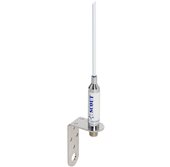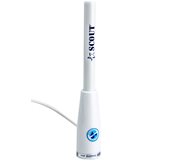The marine VHF antenna is installed on the highest deck of the vessel or on masthead sailboats to allow the marine VHF or DSC to receive and transmit radio signals. It is therefore an important element in optimising the quality of the signals transmitted and received by the on-board VHF.
It is commonly presented as a fiberglass stylus where the dipoles (electric wire) or the active elements of the antenna flow inside.
While the base differs depending on the type of installation, one for installation in the masthead where the antenna is distinguished by a mounting flange on its base that facilitates tightening on the shaft, the other for installations on motor boats where the antenna is equipped with a fitting with 1 x 14 threads, suitable for being screwed on many marine bases on the market.
An important prerogative for a marine VHF antenna is the gain expressed in decibels, normally the longer the antenna the more gain we will have thanks to the greater directionality that the antenna acquires for VHF signals coming from the horizontal plane.
While for professional antennas the antenna should be possibly of a collinear type, which consists of a particular internal arrangement of several elements, to increase directionality and consequently also the gain.

